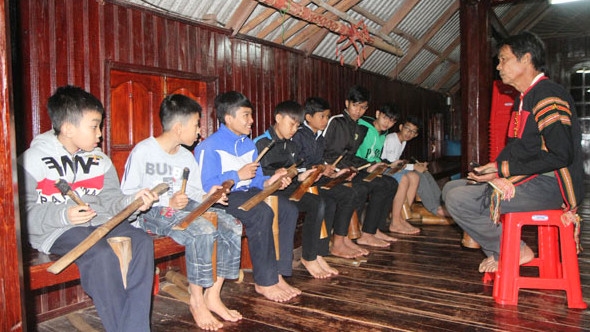Over the past four months, when the clock strikes 6 pm, brothers Y Tam H’Dok and y Nhan H’Dok, two students from the Doan Thi Diem Secondary School in Buon Ma Thuot city, Dak Lak province, join their friends at the private house of artisan Y Hiu Nie Kdam to learn how to play gongs.
The class has 12 students, most of them living in Ale A and Mduk villages. The youngest member is a fourth grader, while the eldest is 17. During the free class, students learn the basic principles of playing bamboo and bronze gongs, how to “feel” the sound of the traditional musical instrument, and practise on two sets of bamboo gongs, which were produced by their teacher.
Living in Mduk village, Ea Tam ward, Buon Ma Thuot city, Y Hiu Nie Kdam can play and produce many traditional musical instruments of the E De people. With a desire to share his skills with others, he opened his first class in 2002.
At the end of the course, the majority of learners in his class were able to deliver proper performances of gongs, this result was much better than the two previous classes hosted at the same time by the neighboring village.
Since then, many of his students, who are only at ages between 12 and 13, can join with the veterans of the choir to perform at weddings, funerals, and other special occasions.
A tall and thin elderly man riding a bicycle to gong classes has become a familiar sight to Ede ethnic children in Buon Ma Thuot city whenever summer comes.
According to Y Hiu Nie Kdam, a gong performer can’t perform individually as he has to perform in a choir in which the gongs are harmoniously in tune with each other. “My greatest joy is when I meet my ex-students again when they are performing at festivals and competitions,” he said.
Y Hiu Nie Kdam can’t remember how many gong classes he has taught over the past 15 years. His teaching isn’t based on specific instructional books but it is mainly oral, in which he helps the students to “feel” the gong beat. His classes, which last between two and three months, have fuelled and inspired the love for traditional cultural treasures among the community’s younger generations.
The passion for gongs is also spread from the participating children to their parents. When Y Joen Nie Kdam brought his son, Y Tam H’Dok, to the gong class, he stayed on and became interested in the art of gong playing. He then encouraged his friends to join him at the class, which is dedicated to adults.
The only teaching tool of Y Hiu’s class is a set of two bamboo gongs he has made by himself. He hopes to collect enough money to buy a small-sized set of bronze gongs because the bronze gongs available at his house are too weighty for children.
He also plans to open classes for younger elementary school students and classes on other traditional musical instruments such as goong, dinh nam, and dinh buot.
Although parents have asked to pay tuition fees for Y Hiu, he always refuses. He is of the opinion that whenever he is still in good health, he will continue his teaching career so that the valuable cultural treasure of the ancestors will be kept alive forever.




